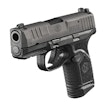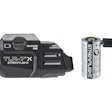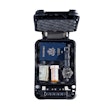You don't like doing it, I don't like doing it…no one I know likes shooting with one hand. Why? Because it is twice as hard as shooting with two hands and we all want to look good and shoot our best at the range. Quite often, how you shoot determines whether or not you go back to the street or end up in an office job riding a desk.
Shooting a handgun is tough. Anyone who tells you it is not is kidding him or herself. Unlike long guns, which allow four points of contact (fore grip, shooting grip, shoulder weld, and cheek weld), a handgun allows for one point of contact: the shooting hand.
What, you say that the handgun offers two points of contact? To some degree this is true, but the second point of contact is wrapped around the first. All of us have heard of sympathetic muscle response (what one side of the body does, the other will do to a lesser degree), so it is not that hard to see that two points of contact on a long gun are not quite the same as two points of contact on a handgun.
Going Solo
Take a moment and think about the difficulty in shooting a handgun accurately. All day long, you go through your daily routine with the fingers of your hands working in concert with one another, i.e. opening and closing as a group. Then several times a year, your department puts a handgun in your hand and asks you to use your hand in such a way that the index finger must operate independently of the rest.
If the hand moves as a unit, which is normal, then the muzzle of the pistol will swing off target and you will miss your shot. The support hand helps stabilize the shooting hand in this endeavor, but as many of us know, it is oftentimes not enough.
Beyond Qualifying
With some practice, the majority of police officers can shoot reasonably well with two hands, but when it comes to one-hand shooting, many just hope for the best. And when it comes to shooting one-hand style with our support hand (I still like to call it the "weak hand"), I have seen many an officer just give up and hope that the rest of his or her shots will yield a "qualifying score."
Qualification is not enough. We must shoot well enough to be active participants in our own rescue in the event we are the subject of a deadly force attack.
Those of us who are firearms instructors can testify to many targets in which the "bad guy" is shot quite frequently in the gun hand. This has also been documented in actual gun battles. This phenomenon is not surprising, as most people will focus on the potential threat, which means the gun in your hand.
If you are shot in the hand during a gunfight, there is no time out. You will need to return fire with one hand, and it may be your support or weak hand.
Techniques
Shooting with one hand is not really that difficult, though I will admit that very few of us will get as good with one hand as we are with two. However, this being said, most of us can get good enough to defend ourselves with some practice and proper technique.
The most common technique used for shooting with one hand is to cant the gun slightly and step into the gun, using the upper body to help control recoil. While this does help, I have found that there are a few potential drawbacks to using this technique exclusively when shooting one handed.
We need to think about what the circumstances will be in which one hand shooting will be used. Two situations come to the mind of most officers: when one hand is injured and when the engagement is quite close.
For close-quarter situations, does it make sense to step into the suspect and outstretch your arm? If the suspect is close, you run the risk of placing your gun within his or her grasp. If you try to pull the gun back to shoot in a close retention position, your forward step will place you too off balance to repel the attack since there will be nothing behind your upper body to help retain balance. Again, not good.
I teach a one-hand shooting stance that is a bit different than what is normal and I have had a great deal of success with it. In reality, it is not much different than the stance that many people use with two hands, which makes it quite easy for most people to pick up quickly.
To use this stance, stand as you normally would with your feet square to the target or with the shooting side foot slightly behind the support side. Extend your shooting arm and rotate your elbow down toward the ground in a "six o'clock" position and "roll" your upper body toward the target. By doing this, you will lock the gun on target and control recoil for each shot by letting your upper body bring the gun back on target.
Keep your non-shooting hand locked to your body in some fashion so that it will not take you off balance. In actuality, this stance is the same as the one you would use when shooting with two hands, you are just taking one hand off the gun and locking it in place. As it is a continuous motion with something else you are already doing (two hand shooting), it will feel somewhat familiar making it easier to accomplish.
The Weak Hand
As far as shooting with the support/weak hand, the easiest way to master the technique is to remember that shooting with the support side is the same as shooting with the primary side, only in reverse.
When shooting with the primary side, take note of how it feels to shoot and then model it using the support side. While it will feel different, it is really the same.
Practice will overcome the odd feeling that using the support hand brings. It is important to focus/concentrate on what you are doing as total concentration will compress the time needed to master one-hand shooting. While in practice, it may be a good idea to reverse the position of your feet when changing hands. It's not so good in a real fight, as such a change will burn up valuable time. As your practice progresses, try and switch hands without switching feet.
Switching hands is also a necessary shooting technique for the law enforcement officer. The two techniques that I have found work best I call the "neck-down" and the "open hand" techniques. One of these two techniques will fill your need and which you choose will likely depend on the size of your hand.
The open hand technique I have found to work best for officers who have large hands or long fingers. When changing hands, the officer merely opens the back strap of the pistol by holding it with the forward fingers around the front strap. The off-hand then takes its place on the back strap and releases with the fingers.
For officers with smaller hands, I recommend "neck-down" on the pistol, opening the grip tang for the off-hand. Once the off-hand is in place on the grip tang, the fingers will wrap around the grip as the shooting hand fingers vacate.
Shooting with one hand is a necessary survival skill. It is as important as proper vehicle placement on a traffic stop or maintaining an advanced state of awareness. And as with many worthwhile things, one-hand shooting requires practice.
Lt. Dave Spaulding of the Montgomery County (Ohio) Sheriff’s Department is a POLICE Advisory Board member and author of “Handgun Combatives.”












